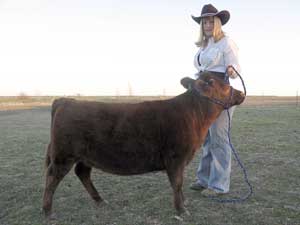Can Raising Dexter Cattle Save You Money?
As rural Texas becomes less rural, and land is divided into smaller plots. The large ranches have all but vanished, swallowed up by the track houses and urban sprawl. Many families want to continue to honor their rural roots, but find the cost of acquiring and holding land prohibitive.
 With smaller tracts of land
available many families are returning to smaller scale ranching operations. This
forces the operation to raise and produce more per acre if it is going to be
anything other than a hobby. The choice to raise the Dexter breed is a personal
preference, but I will list my reasons supporting this choice.
With smaller tracts of land
available many families are returning to smaller scale ranching operations. This
forces the operation to raise and produce more per acre if it is going to be
anything other than a hobby. The choice to raise the Dexter breed is a personal
preference, but I will list my reasons supporting this choice.
- Dexter cattle are smaller than most breeds of cattle. The average size of a mature Dexter bull is about 1,000 pounds and a mature cow is about 800 pounds. The size of the animals makes them easier to handle. The small size and weight allow you to work them with smaller, less expensive fences and pens. This small size also allows you to raise twice as many head per acre when compared to ordinary cattle.
- Dexter cattle are very gentle in nature. Dexter cattle breeders comment on the gentle nature of these animals. A number of breeders have cattle so gentle they can work on the animals without a squeeze shoot or working pen. This is not recommended, but it shows how gentle the animals can become. Try that with your average beef cattle!
- Dexter cattle are a very hardy breed. They can survive well in hot and cold climates. They have a long life expectation, and have been know to breed and calve until they reach twenty years of age. Calves are small, so even young heifers have little or no problem calving.
- Finally, raising Dexter cattle can save you property taxes if you qualify for agriculture appraisal of your land. The average Dexter herd is approximately 10 animals and reside on about 30 acres or less.
How Do
I Qualify For Agriculture Appraisal?
Since 1961, farmers and ranchers
have been exempt from paying sales and use tax on many agricultural items,
including horses, mules and work animals, and feed for farm and ranch animals,
according to Rural Texas in Transition. Other exempt items include certain seeds
and annual plants; chemicals used on a farm or ranch in production; machinery
and equipment used on a farm or ranch to build roads or water facilities; and
items used to pack, produce or market agricultural products and other items.
The Texas Tax Code also exempts from local property taxes "implements of husbandry"--equipment and machinery such as tractors, cultivators and combines--used to produce farm or ranch products, or other implements that farmers and ranchers might use in their operations. Since husbandry items are exempt from taxes, tax appraisers do not appraise them or count them.
Since 1978, Texas landowners have benefited from a special property tax appraisal designed to keep land in agriculture or timber, making owners less likely to sell to developers as a result of the increasingly high property values that come with suburban development. Tax appraisers appraise agricultural land not at its market value but at its productivity value, or its capacity to produce agricultural or timber products.
To qualify for the agriculture
appraisal you must meet certain guidelines. The Texas Constitution permits
special agricultural appraisal only if land and its owner meet specific
requirements defining farm and ranch use. Land won’t qualify simply because it
is rural or has some connection with agriculture. Neither will it qualify
because it is open land that has no other possible use. The law does not
guarantee a tax break for everyone who makes a living from the land. Casual uses
such as home vegetable gardens do not really constitute agriculture.
Section 23.51 of the Property Tax Code sets the standards for determining
whether land qualifies: “Qualified open-space land means land that is currently
devoted principally to agricultural use to the degree of intensity generally
accepted in the area.”
“Qualified open-space land” means land that is
currently devoted principally to agricultural use to the degree of intensity
generally accepted in the area and that has been devoted principally to
agricultural use or to production of timber or forest products for five of the
preceding seven years or land that is used principally as an ecological
laboratory by a public or private college or university. Qualified open-space
land includes all appurtenances to the land. For the purposes of this
subdivision, appurtenances to the land means private roads, dams, reservoirs,
water wells, canals, ditches, terraces, and other reshaping of the soil, fences,
and riparian water rights.
To qualify his land for agricultural
appraisal, the property owner must show the chief appraiser that his land meets
the Sec. 23.51 standard. To do so, the property owner must apply for the
appraisal. The owner must give the chief appraiser all the information he needs
to determine whether the land qualifies. The property owner must also inform the
chief appraiser of any changes in the status of his land.
Application for agriculture appraisal must be filed by no later than April 30 of the year you are applying for the agriculture appraisal. This is a link to the form you will need to file with your local appraisal district. http://www.window.state.tx.us/taxinfo/taxforms/50-129.pdf

